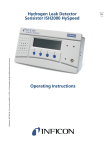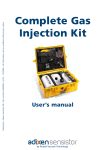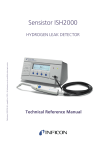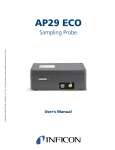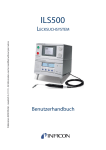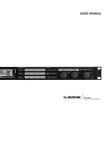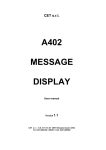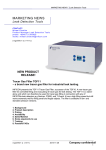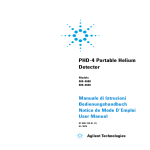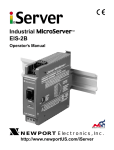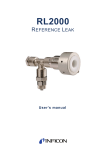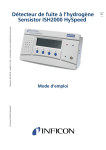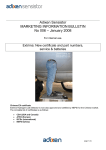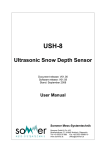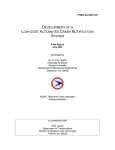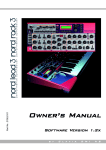Download "user manual"
Transcript
PLUS (V4.0) TM-H2000PLUS-ENG-050916 Technical Manual Hydrogen Leak Detector H2000 PLUS H2000-C PLUS H2000-P PLUS Contents 1 2 3 4 Scope of this manual ............................................................................................................... 1 Principle of Operation .............................................................................................................. 1 Installation ................................................................................................................................ 1 Adjustable Parameters ............................................................................................................ 3 4.1 Engineering Format ......................................................................................................... 3 4.2 Description of Parameters............................................................................................... 3 4.3 Range and Default Settings of all Parameters............................................................... 6 5 Calibration ................................................................................................................................ 7 5.1 General............................................................................................................................. 7 5.2 Setting up calibration parameters ................................................................................... 7 5.3 Password protected calibration.....................................................................................10 5.4 Sensor condition indicator .............................................................................................10 5.5 Calibration messages ....................................................................................................11 6 Active Probe Sampling ..........................................................................................................12 6.1 Dead volume of chamber ..............................................................................................12 6.2 Sampling hose and filter ................................................................................................12 6.3 Location of sampling inlet ..............................................................................................13 7 Active Probe Control..............................................................................................................14 7.1 APC program syntax. ....................................................................................................14 7.2 Programming Hints........................................................................................................23 7.3 APC Program Example 1..............................................................................................25 7.4 APC Program Example 2..............................................................................................28 7.5 Installing APC drivers.....................................................................................................29 8 Downloading parameters to H2000 PLUS...........................................................................30 8.1 Settings of the RS232 serial communication: ..............................................................30 8.2 Supported Parameters ..................................................................................................30 8.3 Transfer of parameters: .................................................................................................30 9 H2000 PLUS commands ......................................................................................................31 10 Service Mode .....................................................................................................................32 10.1 Logging in...................................................................................................................32 10.2 Menu options..............................................................................................................33 10.3 Service Mode Display................................................................................................35 10.4 Service Mode I/O Control ..........................................................................................37 11 Printer Port .........................................................................................................................38 11.1 Connector Pin Configuration .....................................................................................38 11.2 Selectable Printer Types ...........................................................................................39 12 Probe Control Port .............................................................................................................42 13 Status Signal Patterns .......................................................................................................43 14 Specifications .....................................................................................................................44 14.1 Sensitivity....................................................................................................................44 14.2 Table Top Model - General .......................................................................................45 14.3 Table Top Model – Probe Control Port Connector ..................................................46 14.4 Panel Mount Model - General ...................................................................................47 14.5 Panel Mount Model - Connectors .............................................................................48 14.6 Battery operated model - General.............................................................................49 -1- 1 Scope of this manual This manual covers three different instruments in the H2000 PLUS series of hydrogen leak detectors: Hydrogen Leak Detector H2000 PLUS (Table top model) Hydrogen Leak Detector H2000-P PLUS (Panel mount model) Hydrogen Leak Detector H2000-C PLUS (Battery operated model) The H2000 PLUS and H2000-P PLUS models differ only in appearance and supply voltage. The Battery operated model H2000-C PLUS does not have the Active Probe Control (APC) system. The “Active Probe Control” and “Installing APC Drivers” sections do therefore not apply to the H2000-C PLUS model. See the respective specification for further details on differences between model. 2 Principle of Operation The H2000 PLUS detector is based on microelectronic sensor technology known as MIS-FET technology. The sensor is a field effect transistor in an integrated circuit. The gate electrode of the transistor is made of a hydrogen absorbing metal alloy (metal hydride). When this device is exposed to hydrogen the gas molecules adsorb on its surface, dissociate into hydrogen ions (protons), and diffuse rapidly into the gate metal. The absorption of hydrogen ions affects the work function (surface potential) of the metal, which gives the same effect as if the gate voltage of the transistor was changed. Only hydrogen ions can diffuse into the metal. This excludes cross sensitivity from substances that does not contain hydrogen. Also, the dissociation of hydrogen from other molecules is very inefficient, a fact that makes these sensors practically insensitive to other substances. The only, relatively common, substance being detected is H2S, hydrogen sulphide. This gas is, however, extremely toxic and has a very strong and distinct smell. It is therefore never present in interfering concentrations in normal working environments. The electrical output signal from such sensors are, not at all as stable and repeatable as, for example, sensors for physical parameters such as temperature, pressure, etc. Therefore the output signal must undergo signal interpretation in order to give reliable measurements. This is done by a microprocessor in the instrument, which also controls, the sensor temperature with high accuracy, and other sensor diagnostics in order to ensure functionality. It also automatically compensates for background gas. 3 Installation Important! The 25-pin D-type connector on the back of the instrument is not a computer or printer port. Connecting a printer or any other computer device may cause permanent damage to the connected device. Always switch power off before disconnecting or connecting any cable. Installation and set up of table top model when using passive probes (e.g. Hand Probe H50) is described in the User Manual. For connection of other probes, please refer to respective probe manual. -2- The panel mount model can be installed in the operator’s panel or any other flat surface of your leak tester. Mounting brackets and panel rubber seal is delivered with the detector. The detector should preferably be mounted on a vertical surface. Tilting more than 30 degrees is not recommended. Tilting more makes air circulation poor resulting in increased temperature inside detector. This will reduce contrast of display and lifetime of lamp and electronic circuits. IMPORTANT! Verify that ambient temperature is below 50 C. Panel cut out: 262±2 mm Free space vertically >330 mm 127±2 mm Free space horisontally 300 mm Panel cut out: 262 x 127 mm. Maximum panel thickness: 8 mm Allow an extra 20 mm on left and right side for mounting brackets. Leave at least 100mm above and below for air circulation. Install the detector as follows: 1. Cut hole in panel according to figure above. Remove burrs. 2. Check that rubber o-ring is in correct position in the grove around the edge of the detector. 3. Put the detector in place in the panel hole. 4. Hold the panel in place while fixing the mounting brackets to the detector (See figure below). 5. Align the detector horizontally and lock it by tightening the 4 set screws. 6. Lock the set screws with the locking nuts. 7. Connect ground terminal to protective ground of cabinet. Set screw Bracket screws Bracket Electrical connections are described under “Specifications” below. -3- 4 Adjustable Parameters 4.1 Engineering Format Some of the parameters of the detector are written in engineering format. This format can represent a very wide range of numbers from very small to very large numbers. The following examples describes the format used in the detector: 1.00E+01 = 1.00 x 10 1 = 10 1.00E+00 = 1.00 x 10 0 = 1 1.25E-02 = 1.25 x 10 -2 = 0.0125 4.2 Description of Parameters Below is a list and description of all adjustable parameters of the H2000 PLUS detector. The parameters are listed in order of their appearance in the menu system. Please refer to the “User Manual” and the “Service Menu” sections below, for the exact menu position of each parameter. Contrast Contrast level of display. Higher value gives higher contrast. The contrast may need adjustment if ambient temperature changes. Brightness Brightness of display lamp. Screen Save Timeout Display lamp will dim to half brightness if instrument is left idle for the number of minutes set by this parameter. The display lamp will return to the set brightness if any of the display buttons is pressed and if a gas signal is detected. Sensitivity Sensitivity of audio signal and signal bar in Detection Mode. NOTE! This does not affect the Analysis Mode. Auto Range Set this parameter to ON for auto ranging of sensitivity in Detection Mode. Sensitivity will decrease two steps if signal reaches full scale. Sensitivity is restored to selected “Sensitivity” (see above) when signal returns to zero. Direct Sensitivity Adjustment Setting this parameter to “OFF” will remove the sensitivity adjustment from the Detection Mode display. Sensitivity can still be adjusted in the “Sensitivity Settings” menu after giving password (if set). NOTE! The sensitivity setting only affects the Detection Mode. Lowest Frequency Frequency of audio signal when not detecting gas. Dead Band The Dead Band function can be used to mask low signals. This can be handy if working with high sensitivities and noisy signal. Increasing the Dead Band will raise the threshold at which signals will affect the sound and signal bar. NOTE! Dead Band applies only to Detection Mode. Dead Band will be automatically reset to zero if sensitivity is changed. Probe Type Select the connected probe. Chose between “Hand Probe (H50)” and one more probe driver installed from disk delivered with active probe (if ordered). -4- APC Time A Adjustable timer used by the APC system. Select APC Time A and press “Enter” to display specific use of Time A. APC Timer A can be used for general purposes in a custom APC program. APC Time B Adjustable timer used by the APC system. Select APC Time B and press “Enter” to display specific use of Time B. APC Timer B can be used for general purposes in a custom APC program. APC Time C Adjustable timer used by the APC system. Select APC Time C and press “Enter” to display specific use of Time C. APC Timer C can be used for general purposes in a custom APC program. APC Time D Adjustable timer used by the APC system. Select APC Time D and press “Enter” to display specific use of Time D. APC Timer D can be used for general purposes in a custom APC program. Measure Button Setting this parameter to ON display “Measure” over the left button. Pressing “Measure” will initiate a sample cycle. Purge Level Signal level controlling the Purge_Level APC Triggers. Standard probes that support active sampling use the Purge Level for fast interruption of sampling that result in high gas signals. Setting Purge Level equal to, or just above, Leak Alarm Level will give fastest possible cycle times for those probes. Quick purging also enhances signal repeatability. NOTE! Purge level interrupts active sampling of APC probes. This means that higher signals will be underestimated as the sensor is purged before full signal has developed. See also under ”Printer Port”. Leak Alarm Level Threshold for leak alarm. N.B. The frequency of the acoustic signal in Analysis Mode is controlled by the Leak Alarm Level. A signal equal to the Leak Alarm Level will always give the same audio frequency irrespective of the actual signal strength. Min Presentation Time Signal values in Analysis Mode will never be presented shorter than this time. Values are, however, always presented until signal has recovered. Language Language used in the menu system. Calibration Time The detector will look for maximum signal from calibration source during this time. This is also the timeout of the Calibration line in an APC program. Calibration Coefficient Value of calibration reference. N.B. Calibration Coefficient must be given in same unit as Leak Rate Unit. See User Manual for further explanation. Leak Rate Unit The Leak Rate Unit is a text string with a maximum of 12 characters. It is not involved in any calculations. Make sure that you are using same unit for as for your calibration reference (see Calibration Coefficient). The following characters can be used: Upper and lower case English letters, the numbers 0 to 9, Å, Ä, Ö, å, ä, ö, %, / and -. Space ( “ “ ) is not supported. The string will be truncated after the first space found. Password Text string (max 12 alphanumerical characters) used to lock critical parameters. Setting password to an empty string (no characters) means that no password is needed to modify the critical parameters. The default is no password ( “” ). Password Protected If this parameter is set to “ON” you will be prompted for password when -5- Calibration starting a calibration. Setting Password Protected Calibration to ON has no effect is no password is set. APC controlled calibration can be started from the bus in both cases. Clock Real time set as hh:mm:ss. Hours and minutes can be adjusted. Seconds will automatically be set to 00 when hours and minutes have been set. Clock runs even when detector is disconnected from the mains. Date Real Time Clock date set as YY-MM-DD. Example: 00-12-31. Clock runs even when detector is disconnected from the mains. Printer Type See “Printer” section below. Detector Signal Level Signal level below which the detector is considered to have recovered from previous gas signal. Carefully read “Service Mode” section before changing this parameter. Min Calibration Time This defines the lower limit of the parameter “Calibration Time”. Carefully read “Service Mode” section before changing this parameter. -6- 4.3 Range and Default Settings of all Parameters Parameter Range Default Contrast 0 – 20 10 Brightness 0 – 63 63 Screen Save Timeout 1 – 60 min 20 min Sensitivity 1 – 13 5 Auto Range ON/OFF OFF Direct sensitivity adjustment ON/OFF ON Lowest Frequency 0 – 10 Hz 1 Hz Dead Band 0 – 14 0 Probe Type Hand Probe H50* + 1 installable APC Driver Hand Probe H50 APC Time A 0.0 – 6000.0 s 10.0 s APC Time B 0.0 – 6000.0 s 0s APC Time C 0.0 – 6000.0 s 0s APC Time D 0.0 – 6000.0 s 0s Measure Button ON/OFF OFF Purge Level Leak Alarm Level – 1.00E37 1.00E+02 = 100 Leak Alarm Level 1.00E-37 – 1.00E37 1.00E+01 = 10 Min Presentation Time 120 s 1s Language Several choices English Calibration Time Min Calibration Time – 30 s 10 s Calibration Coefficient 1.00E-37 – 1.00E37 1.00E+00 = 1 Leak Rate Unit Max 12 characters “PPM” Password Max 12 characters “” = No password Password protected calibration ON/OFF OFF Clock hh:mm:ss - Date YY-MM-DD No Printer PC Printer Analysis data output Detection data output - Printer Type No Printer Detector Signal Level 0 – 100 % 20 % Min Calibration Time 0 – 30 s 5s * The “Hand Probe H50” driver handles all passive hand probes. I.e. probes not requiring any specific I/O control such as valves etc. -7- 5 Calibration 5.1 General Calibration is a natural part of leak measurement and an important factor in Quality Assurance. Calibration is easily done using the internal calibration function. Before explaining the details of the calibration procedure we must, however, point out some facts. The H2000 PLUS detector has two measuring modes: Analysis and Detection Mode. The Analysis Mode is used to quantify leaks and should therefore be calibrated as described below and in the “User Manual”. The Detection Mode is primarily intended for locating leaks. The two modes are only affecting the way the signal is presented to the operator. In Analysis Mode the detector presents an absolute number signifying the size of the leakage and also a sound whose frequency is proportional to the number shown. In Detection Mode the operator will instead hear a sound whose frequency varies continuously with the concentration of hydrogen in the sensor. The same signal is also presented as a horizontal bar on the display. IMPORTANT! The leak alarm is active in both modes and leaks will be correctly evaluated against the leak alarm level also when instrument is in Detection Mode. The sensitivity setting of the Detection Mode does not in any way affect the calibration of the instrument. It just changes the sensitivity of the audio frequency and the bar in the detection mode. Note that Sensistor that certain probes such e.g. the AP57 are solely intended for locating leaks and that those probes can normally not be calibrated to the same accuracy. 5.2 Setting up calibration parameters 5.2.1 Leak Rate Unit The Leak Rate Unit is a text string with a maximum of 12 characters. It is not involved in any calculations. The relation between the leak rate unit and the gas concentration is defined by the Calibration Coefficient. The following characters can be used: Upper and lower case Roman letters, the numbers 0 to 9, ü, Ü, Å, Ä, Ö, å, ä, ö, %, /, (, ), and – (dash). Space is not supported. The string will be truncated after the first space found. You can use any unit you like as long as it contains a maximum of 12 characters. (for example: sccm, mm3/s, oz/yr, g/a-R134a, etc. The unit can also be a concentration (for example: PPM or mg/ml-H2, etc). Note that space ( “ “ ) is not supported. The leak rate unit string will be truncated at the first space found. See also under “Adjustable parameters” above. N.B. It is strongly recommended that the Leak Rate Unit is set to that used on your calibration reference. I.e. the unit used in the calibration certificate of your reference leak or reference gas. If you use another Leak Rate Unit you must also recalculate the calibration value of your reference in that same unit. 5.2.2 Calibration time The calibration time decides how long time the detector shall look for a reference signal before giving up. If the calibration is set to e.g. 6 seconds the detector will record the maximum signal during 6 seconds after that the operator (or external hardware) orders a calibration. It is very important that all delays in gas exposure as well as reaction time of sensor are taken into consideration when setting the calibration time. Calibration will not be correct if the maximum signal comes after that the calibration time has terminated. -8- 5.2.3 Calibration Coefficient The Calibration Coefficient tells the detector the magnitude of the reference leak flow or reference gas concentration respectively. Set the Calibration Coefficient equal to the calibrated value of your reference. (See also under “Leak Rate Unit” above) Check afterwards that the calibrated instrument gives the correct reading when the probe is exposed to the reference. After a calibration, the display will show the measured value using the updated calibration value (internal). This value can deviate slightly from the calibration coefficient. This is due to variation in the previous calibrations. H2000PLUS uses the average of recent calibrations to calculate the calibration factor. 5.2.3.1 When measuring hydrogen concentration When measuring hydrogen concentration (instead of leak flow) you should calibrate the detector against a reference gas with a known concentration. The reference gas should be Hydrogen in Synthetic Air. (Hydrogen in Nitrogen can also be used, but the accuracy may not be as good. The concentration of the reference gas should be chosen near to the alarm level (or primary target range), and always within the range of 2 PPM - 400 PPM. Select the concentration preferably at or slightly above the “Leak Alarm Level” for best accuracy. See also section “Selecting the reference”. Set the Calibration Coefficient equal to the Hydrogen concentration in your reference gas. This can be found on the certificate of analysis issued for the gas. N.B. Remember to set the “Leak Rate Unit” to the same unit as that used to express the concentration. Set-up and calibration: 1. Set “Leak Rate Unit” equal to the desired unit of concentration(typically “PPM”). 2. Set the Calibration Coefficient equal to the concentration of hydrogen in the reference gas. 3. Enter the Calibration menu and press START. 4. If using a hand probe; immediately put the probe in a stream of reference gas. Remove probe when gas has been detected. Automatic probes will perform this step automatically. Repeat steps 3 and 4 until calibration is OK. 5. Press SAVE. (Automatic probes will save automatically) Example: Reference gas contains 10 PPM Hydrogen in synthetic air. Set the Calibration Coefficient = 10 and Leak Rate Unit = “PPM”. NOTE! You will need to repeat the calibration typically 2-3 times to get “Calibration OK” after changing setup or probe. Remember to allow at least 30 s between each calibration for best accuracy! -9- 5.2.3.2 When measuring Leak Flow When measuring leak flow you should calibrate the detector against a reference leak. Also in this case the detector generates a signal which is proportional to the change in hydrogen concentration. It then calculates the corresponding leak flow, in the selected unit, by multiplying the signal with the Calibration Coefficient. The reference leak should have a flow near to or slightly bigger than your chosen leak alarm level. See also section “Selecting the reference”. Set the Calibration Coefficient equal to the calibrated flow of your reference leak. This can be found on the calibration certificate issued for the leak. N.B. Feed the reference leak at the pressure stated on the calibration certificate. If another pressure is used you must correlate the resulting flow and use this value as “Calibration Coefficient”. The Calibration Coefficient must reflect the flow through the leak at the moment you calibrate the H2000 PLUS detector. N.B. Remember to set the “Leak Rate Unit” to the same unit as that used to express the leak rate of the reference leak. Set-up and calibration: 1. Set leak rate unit to that specified on the reference leak. 2. Set the Calibration Coefficient equal to the actual flow of the reference leak. 3. Enter the Calibration menu and press START. 4. If using a hand probe: Immediately put probe on the opening of the reference leak. Remove probe when gas has been detected. Repeat steps 3 and 4 until calibration is OK. 5. Press SAVE. Example: Reference leak rate is 4.2E-5 mbarl/s. Set Calibration Coefficient = 4.20E-05. Set Leak Rate Unit = “mbarl/s” NOTE! You will need to repeat the calibration typically 2 times to get “Calibration OK” after changing set-up or probe. Remember to allow at least 30 s between calibrations for best accuracy! Go to Analysis Mode and check that the detector shows the same value and unit as marked on the reference leak (allowing for the specified uncertainty of detector and reference). - 10 - 5.2.3.3 Selecting the reference Your reference should have a concentration or flow equal to or slightly above what you want to measure. See the examples below for specific recommendations Instrument specification is valid for concentrations ranging from 0.1 to 10 times the leak alarm level, but not outside the sensitivity range (0.5 to 2000 PPM). You should use reference gas if measuring Hydrogen concentration and a reference leak if measuring leak flow. Example for reference gas: Leak alarm level is set at 8 PPM A reference gas mix containing 8 PPM hydrogen in synthetic air will give best accuracy. For good accuracy, reference gas should be within 50% of leak alarm level. In this example this means 4 to 12 PPM Hydrogen. Concentration of hydrogen should always be within 2 PPM to 400 PPM. Example for reference leak Leak alarm level is set at 2.0E-4 atm.cc/s A reference leak calibrated to 2.0E-4 cc/s will give best accuracy. For best accuracy, reference leak should be within 50% of leak alarm level. In this example this means: 1.0E-4 to 4.0E-4 atm.cc/s. 5.3 Password protected calibration Correct calibration is essential for the Quality Assurance. Calibration should be done regularly and by adequately trained personnel. If the operator lacks the necessary skill you can put calibration under the general password. This is explained in the “User Manual”. If protected, you need to enter the password before starting a new calibration. N.B. The detector is delivered with no password. Calibration is only protected if a new password is set. 5.4 Sensor condition indicator When the instrument is calibrating it shows a sensor condition indicator in the lower mid part of the screen. This indicator can be used for an early warning as to when a sensor replacement will be needed. A bar grows when the sensor is detecting reference gas. The length of the bar shows the condition of the sensor. The bar will become shorter if sensor has lost some sensitivity. The scaling of the indicator is not exact enough to say at exactly what length the sensor must be replaced. You will however learn when this happens for your particular application. The instrument will also tell you in clear text when sensitivity is too low. See further in the next section below. - 11 - 5.5 Calibration messages Below is a list of the different messages that can be displayed during calibration. Message Expose to background … Detecting gas Explanation Prepare the probe for calibration by holding it in hydrogen free background. Gas signal is detected. Remedy Normal operation, gas exposure can be interrupted. Wait 30 s and calibrate again. Press save to store calibration in memory. Check reference. Gas valve may be shut. Check that probe tip is not clogged. Background is higher than reference gas concentration. Improve ventilation. Check reference. Gas valve may be shut. Check that probe tip is not clogged. Check setting of Leak Alarm Level. Replace sensor if problem remains. Calibration was not within 20% of last. Calibration was within acceptable limit. No gas signal or no stable signal detected during calibration. Signal when reference gas is shut off. Happens for reference gas only. Sensitivity too low Sensitivity of sensor is too low to guarantee correct response to a gas flow for alarm level or concentration equal to the leak alarm level. The most likely reason is that sensor is too old. Check that reference gas mix is not High signal! Check Reference signal is abnormally high. replaced with tracer gas mix. reference! Check condition of reference. Check that reference leak connections has no leaks. Repeat calibration Calibration OK No gas or unstable signal. If calibration fails you can still use the instrument. Last valid calibration parameters will be used. You should, however, check that the instrument reacts to the reference. - 12 - 6 Active Probe Sampling This section applies mainly to integral testing using a gas collecting hood or chamber. Sampling in the hydrogen method is most commonly done at atmospheric pressure and not in high vacuum. This makes chamber design very much easier than for a high vacuum chamber. There are, however, three important factors to consider when designing an atmospheric pressure test chamber. • The dead volume in the chamber directly influences the sensitivity and eventually the cycle time. • Sample transport from chamber to sensor easily adds seconds to the test time. • Leaks of equal size at different positions in the chamber can give considerably different signals if adequate mixing is not achieved. 6.1 Dead volume of chamber When measuring the total leak rate of an object by enclosing it into a chamber, the concentration of hydrogen will increase linearly with time. The rate of increase will depend on the leak flow and the volume in which the leak flow is mixed with ambient air. The bigger the dead volume the slower the concentration will grow. The dead volume should therefore normally be kept as small as possible so that the accumulation time, and thereby the total cycle time, can be kept short. In all but very small chambers it is necessary to provide forced circulation to mix the leaking gas evenly in the dead volume before taking a sample. See further under “Locating of sample inlet” below. 6.2 Sampling hose and filter Sampling is normally done through a sampling hose carrying the gas sample from the test point (or chamber) to the sampler. This hose should be kept as short and narrow as possible to minimise cycle time. Sensistor’s samplers incorporate built in sample inlet filters. These do however have limited capacity and must be cleaned or replaced at rather short intervals if there are high levels of dust and other particles in the samples. An external filter is fitted in the sample hose will greatly prolong the service intervals. This is at the cost of prolonged sampling time, however. Generally we recommend a sample hose with inner diameter within the range of 1 – 2 mm. - 13 - 6.3 Location of sampling inlet When designing the test chamber it is essential that the sample inlet is placed in a correct position relative to reference inlet, circulation fans etc. The following issues should always be considered: • The geometry of the test object and the chamber should be considered when designing the circulation device. In a more open geometry it is often enough to place a small electric fan inside the chamber. In many cases you will, however, need to design a circulation bypass, fitted with a pump or duct fan. The inlet and outlet of the circulation bypass should be placed at opposite ends of the chamber so that leaking gas from all points of the object will be caught in the main flow and mixed evenly with the chamber air. Remember that the internal volume of the circulation bypass adds to dead volume of the chamber. • Even if the circulation is ever so well designed a small leak located in a retracted part of the object often gives an unexpectedly low contribution to the gas concentration in the chamber. This is due to insufficient circulation in the confined space in front of the leak. Due to such phenomena it is essential that such influence from location is carefully tested before commissioning the system. Affix your reference in all “problematic” positions and measure the response. Find the point of lowest signal. The easiest way to do this is to use a mass flow controller to set up the reference leak flow through a small hose that can be fitted in the respective positions. If there is a reasonable way of making the mixing better do that. If not, set your leak alarm limit with respect to the point of lowest sensitivity. This will result in a risk that a few leaks just below the limit are being rejected but, safeguards that no leaks above the limit are being passed. Makes sure by repeated testing that leaks in the least favourable position are reliably detected. • The sample hose inlet is best placed in the circulation bypass, downstream of fan/pump. If no alarm is provided for the circulation flow it is better to place the inlet close to the primary leak point to minimise the consequences of circulation pump or fan failure. • If the reference is placed in the chamber it should be placed down stream of the sample inlet. - 14 - 7 Active Probe Control NOTE! Battery operated model H2000-C PLUS does not incorporate the APC feature described in this section. Hydrogen Leak Detector H2000 PLUS is equipped with inputs and outputs for controlling external active probes. Active probes incorporate pneumatics and electronics for sniffing, purging etc. This feature is called APC (Active Probe Control) and works much like an industrial PLC. For each standard probe in the H2000 PLUS Leak Detecting System there is a specific software driver. This driver makes the APC system control the probe in the correct way. The software driver will be delivered with the active probe. To install the driver, simply start the installer program and follow the instructions given. See also under “Installing APC drivers”. The driver for the H50 Hand Probe is built in to the detector. The driver for any other probe as well as custom made APC drivers/programs are installed as the second choice in the “Probe Type” menu. A custom driver is an APC program made for a customer specific purpose such as e.g. special samplers or to control simple test fixtures. This section of the manual describes the programming syntax of the APC system. Each line in an APC program controls the status of the outputs and internal flags according to specified conditions. Single line commands, sequences and loops can be programmed so that a large variety of tasks can be performed. The custom APC program is written on a Windows computer and compiled by the APC Compiler software. The compiled APC program is downloaded to the H2000 PLUS via a standard serial 9-pin RS232 cable. Understanding the basic functions and the menu structure of the H2000 PLUS detector is essential for successful APC programming. Some previous experience of software design is also helpful. We recommend that you use a “Bus Test Box 2000” to test and verify your program. The test box is an excellent tool and a great help when developing APC drivers. Also use the Service Menu to display the progress of the program line by line. It is recommended that you study the examples below in parallel with reading the text. 7.1 APC program syntax. The editable APC program consists of maximum 32 program lines. Each line consists of the elements listed below. See further description below the list. The elements of a line are separated by commas (,). TRIGGER Line is executed if TRIGGER command is TRUE. PRIORITY The PRIORITY index decides if the line can terminate another executing line. Priority also decides if a running timer should be indicated by a progress bar on the screen. Even priority means no bar, odd priority means bar should be displayed. FLAGs There are 3 internal FLAGs that can be controlled by the APC program line. Status of each FLAG is set according to respective TAG. OUTPUTs There are 9 external outputs that can be controlled by the APC program line. Status of each output is set according to the respective TAG. TIMEOUT Execution of the line terminates when the TIMEOUT has elapsed and the trigger is LO. - 15 - 7.1.1 Line SYNTAX An APC program line is built up as follows: TRIGGER, PRIORITY, FLAGs, TAGs, TIMEOUT FLAGs and outputs are set in the following order, from left to right (see examples): MEAS_PER PROBE_ERROR CAL_PER OUT_6 OUT_5 OUT_4 OUT_3 OUT_2 OUT_1 OUT_0 CAL_CONF LEAK_OUT 7.1.2 TRIGGERs The triggers are set TRUE or FALSE according to the status of internal flags, alarms, outputs and external inputs. The pulse length on an external input should be at least 40 ms for certain switching of the corresponding triggers. Execution of a line starts when its TRIGGER command is TRUE. Execution will, however, not start if another line with same or higher priority is executing. See further under “PRIORITY”. NOT_USED Dummy trigger. NOT_USED can be handy during debugging. A single line can be turned off by changing the trigger to NOT_USED. In a sequence, the line will be skipped and execution will continue on next line. STAND_BY TRUE if all other used TRIGGERs are FALSE and no other lines are running. IMPORTANT! Every program must include the STAND_BY trigger. WARM_UP TRUE when instrument is in WARM-UP mode after power-on, or when recovering after a sensor error. NOTE! A line trigged by WARM_UP is active during instrument start-up, regardless of line priority index. IN_0_HI TRUE if IN_0 input is HI IN_0_LO TRUE if IN_0 input is LO IN_1_HI TRUE if IN_1 input is HI IN_1_ LO TRUE if IN_1 input is LO IN_2_ HI TRUE if IN_2 input is HI IN_2_ LO TRUE if IN_2 input is LO - 16 - IN_3_ HI TRUE if IN_3 input is HI IN_3_ LO TRUE if IN_3 input is LO IN_4_ HI TRUE if IN_4 input is HI IN_4_ LO TRUE if IN_4 input is LO LEAK_ALARM_HI TRUE when sensor signal is above Leak Alarm Level. LEAK_ALARM_LO TRUE when sensor signal is below Leak Alarm Level. DET_SIGNAL_HI TRUE when sensor signal is above Detector Signal Level. DET_SIGNAL_LO TRUE when sensor signal is below Detector Signal Level. PURGE_LEVEL_HI TRUE if sensor signal is above Purge Level PURGE_LEVEL_LO TRUE if sensor signal is below Purge Level SENSOR_ERROR TRUE if sensor or sensor cable is defective. MEAS_LEAK TRUE if sensor signal was above Leak Alarm Level anytime during last measurment. (MEAS_PER). MEAS_LEAK is reset (LO) when execution of this line starts. A program setting the MEASURE flag must include exactly one line starting with the MEAS_LEAK trigger. MEAS_ NO_LEAK TRUE if sensor signal never was above Leak Alarm Level during last MEAS_PER. MEAS_NO_LEAK is reset (LO) when execution of this line starts. A program setting the MEASURE flag must include exactly one line starting with the MEAS_NO_LEAK trigger. CALIB_PASS TRUE if last calibration was accepted by the detector. CALIB_PASS is reset (LO) when execution of this line starts. A program setting the CALIBRATE flag must include exactly one line starting with the CALIB_PASS trigger. CALIB_FAIL TRUE if last calibration was rejected and calibration needs to be repeated. CALIB_FAIL is reset (LO) when execution of this line starts. A program setting the CALIBRATE flag must include exactly one line starting with the CALIB_FAIL trigger. FOLLOW Execution starts when execution of previous line ends. FOLLOW is used to create program sequences. FOLLOW can not be used after WARM_UP or after a line setting either of the CALIBRATION and MEASURE flags. FOLLOW_IF_ Conditional FOLLOW triggers. Execution starts when execution of previous line ends, IF specified basic TRIGGER is TRUE. A sequence will terminate if one FOLLOW_IF trigger in the sequence is FALSE. FOLLOW_IF triggers are used to create program sequences. FOLLOW_IF triggers can not be used after WARM_UP or after a line setting either of the CALIBRATION and MEASURE flags. All FOLLOW_IF triggers are listed below: FOLLOW_IF_IN_0_HI FOLLOW_IF_IN_0_LO - 17 - FOLLOW_IF_IN_1_HI FOLLOW_IF_IN_1_LO FOLLOW_IF_IN_2_HI FOLLOW_IF_IN_2_LO FOLLOW_IF_IN_3_HI FOLLOW_IF_IN_3_LO FOLLOW_IF_IN_4_HI FOLLOW_IF_IN_4_LO FOLLOW_IF_LEAK_ALARM_HI FOLLOW_IF_LEAK_ALARM_LO FOLLOW_IF_LEAK_OUT_HI FOLLOW_IF_LEAK_OUT_LO FOLLOW_IF_DET_SIGNAL_HI FOLLOW_IF_DET_SIGNAL_LO FOLLOW_IF_PURGE_LEVEL_HI FOLLOW_IF_PURGE_LEVEL_LO FOLLOW_IF_SENSOR_ERROR FOLLOW_IF_OUT_0_HI FOLLOW_IF_OUT_0_LO FOLLOW_IF_OUT_1_HI FOLLOW_IF_OUT_1_LO FOLLOW_IF_OUT_2_HI FOLLOW_IF_OUT_2_LO FOLLOW_IF_OUT_3_HI FOLLOW_IF_OUT_3_LO FOLLOW_IF_OUT_4_HI FOLLOW_IF_OUT_4_LO FOLLOW_IF_OUT_5_HI FOLLOW_IF_OUT_5_LO FOLLOW_IF_OUT_6_HI FOLLOW_IF_OUT_6_LO FOLLOW_IF_CAL_CONF_HI FOLLOW_IF_CAL_CONF_LO FOLLOW_IF_DET_WAIT_HI FOLLOW_IF_DET_WAIT_LO FOLLOW_IF_DET_ON_HI FOLLOW_IF_DET_ON_LO FOLLOW_IF_DET_ERROR_HI FOLLOW_IF_DET_ERROR_LO TRUE if signal is above leak alarm level. TRUE if signal is below leak alarm level. TRUE if LEAK_OUT is set HI.* TRUE if LEAK_OUT is set LO.* *The LEAK_OUT output can be set actively by the APC program. The LEAK_OUT will follow the internal leak alarm if no such line exists in the program. See further under “OUTPUTS” below. - 18 - 7.1.3 PRIORITY The PRIORITY index decides if the line may terminate a line currently executing. • A line with higher PRIORITY will immediately terminate the line currently executing. • A line with lower PRIORITY will start executing when all lines with higher priority have been executed. • Lines with same PRIORITY index will be executed in order of their position in the program list, starting from the top. The PRIORITY index is also used to control if a progress bar should be shown on the screen during execution of the line. For example, for a 10 second timeout such a bar will grow from left to right on the screen during 10 seconds. • A line with even PRIORITY will not be indicated by a progress bar. • A line with odd PRIORITY will be indicated by a progress bar. NOTE! The adjustable times A to D can also be assigned descriptive names that will be presented above the progress bar during execution of a line using the respective timer. See further under “TIMEOUT” below. Valid priority indexes are integers within the range of 0 – 255. The actual number used is not important (apart from the odd/even code). Leaving gaps between the PRIORITY indexes used, makes changing and debugging the APC program easier. Each line in a sequence with one or more FOLLOW lines has its own PRIORITY. A high PRIORITY, on the first line only, in a sequence will therefore not prevent termination in mid of sequence. Different PRIORITY on different lines in a sequence can be used to define which steps that can be terminated by a certain event. Example: A line with PRIORITY=7 will terminate a line with PRIORITY=6 but not one with PRIORITY=7 or higher. Choosing the right priority for each line is the most important skill to learn when writing APC programs. Make sure you have tested all possible scenarios before using the program in your process. 7.1.4 FLAGs There are 3 internal FLAGs that can be controlled by the APC program: MEASURE Setting this flag (H) will start a measurement routine in the detector. This measurement routine checks for leak alarms until the MEASURE FLAG is reset (L) again. The trigger MEAS_LEAK will be set TRUE, if gas signal goes above Alarm Level, any time during the measurement period. The trigger MEAS_NO_LEAK will be set TRUE, if gas signal is below Alarm Level, during the entire measurement period. It is strongly recommended that MEASURE is reset (L) by all lines not starting a measurement. Sequencing is not possible after a line setting the MEASURE flag. Follow lines after this line will never execute. NOTE! The detector analyses the sensor signal continuously when not in WAIT routine. Setting the MEASURE flag only means asking the detector if the signal goes above the Alarm Level any time during this particular period of time. - 19 - PROBE_ERROR When set (H), this flag trigs the probe error routine. PROBE_ERROR should be reset (L) by all lines, except those indicating an error in the probe. The probe error routine automatically performs the following: 1) Show “Probe_Error” alarm text. 2) Set the red status LED in fast flashing, error mode. 3) Set DET_ERROR output HI. IMPORTANT! If you use controllable outputs as “Test Accepted” and “Test Rejected” indicators you should set the Reject output HI and the Accept output LO on all lines detecting events that can jeopardise the test result. The LEAK_OUT should be used as “Test Rejected” output in such cases. CALIBRATE Setting this flag (HI) will start the instrument calibration routine when execution of line ends. The calibration routine is independent of the APC programming. TIMEOUT of this line should be set to 1 (or higher). The timeout of the calibration is the “Calibration Time” set in the “General Settings” menu on the display. The detector will log max gas signal during the calibration period. The following triggers will be set when calibration routine ends: CALIB_PASS goes TRUE if calibration is accepted. CALIB_FAIL goes TRUE if calibration is rejected. Sequencing is not possible after a line setting the Calibrate flag. Follow lines after this line will never execute. NOTE! The CALIBRATE FLAG is automatically reset (LO) when calibration routine ends. See further under “General Hints / Calibration” When execution of a line starts, each of the 3 FLAGs is set/reset according to the following TAGs: L = FLAG is reset (LO) H = FLAG is set (HI) NOTE! Toggle (T) and No Change (0) tags can not be used on the internal flags. - 20 - 7.1.5 OUTPUTS 7.1.5.1 Controllable outputs There are 9 driving external outputs that can be controlled by APC programs. Source and sinking capacity is specified under “Specifications”. When execution of a line starts, each of the 11 outputs is set according to the following TAGs: L H T 0 = = = = OUTPUT is set LO (0 VDC) OUTPUT is set HI (24 VDC) Status of OUTPUT is toggled (HI goes LO, LO goes HI) Status of OUTPUT is left in previous state. The controllable outputs are: OUT_0 Driving transistor output. OUT_1 Driving transistor output. OUT_2 Driving transistor output. OUT_3 Driving transistor output. OUT_4 Driving transistor output. OUT_5 Driving transistor output. OUT_6 Driving transistor output. LEAK_OUT Driving transistor output. LEAK_OUT can either be controlled directly by the detector signal or by the APC program. If the LEAK_OUT output is not set (H) or toggled (T) in the APC program it will follow the signal of the detector. In that case it will go HI when signal goes above leak alarm level and go LO when signal recovers again. If you want LEAK_OUT to directly follow the signal you must make sure that all lines in your program set the LEAK_OUT tag low (L) or unchanged (0). CAL_CONF Driving transistor output. CAL_CONF tells the supervising system that the detector has been successfully calibrated. CAL_CONF is set by the APC program. CAL_CONF should be set HI if last calibration was successful. It is recommended that CAL_CONF is set LO by the line or sequence that sets the CALIBRATE flag (starts calibration). NOTE! As all other controllable outputs, CAL_CONF is set LO on power up. It is good practice too perform calibration after power up. The detector can be used when CAL_CONF is LO but calibration may be incorrect. See example for Sample Probe H28. NOTE! We strongly recommend that CAL_CONF output is used for calibration control. Electrically it is, however, not different from the other outputs (OUT_0 to OUT_6). It is therefore possible to use CAL_CONF as an extra general output in applications where there is less need for automatic control of calibration status. - 21 - 7.1.5.2 Non-controllable outputs NOTE! This section is for reference only. There are 4 driving external outputs that can not be controlled by the APC programs. These 4 outputs are controlled by specific signals set by the general software in the H2000 PLUS. Even if not controlled by the APC program the status of these outputs can be used as triggers in an APC program. DET_ON HI when power of detector is on, DET_WAIT HI when detector is warming up (first 60 s after power on). DET_ERROR HI if instrument, sensor or probe error is detected. DET_SIGNAL HI when sensor signal is above “Detector Signal Level”. See “Service Menu” section for details. 7.1.6 TIMEOUT 7.1.6.1 Fixed timeout Starting execution of a line will start a timer set by the TIMEOUT value. One TIMEOUT unit is 100 ms ( 0.1 s ). TIMEOUT is defined as: An integer in the range of 1 – 60000 OR S meaning STOP OR A, B, C or D The code for one of four adjustable timers (See next section). Important! Setting TIMEOUT = 0 means line will be skipped. Compiler will accept TIMEOUT = 0. This is allowed since the adjustable timeouts must support zero time for dynamic shut off of functions. A single line not included in a sequence will stay active: Until 0.1 x TIMEOUT seconds have elapsed. OR As long as the trigger is TRUE (timeout override). OR Until a higher priority trigger goes TRUE. Timeout override in a sequence works differently: Each line in a sequence will stay active until its timeout have elapsed. The last line in a sequence will remain active until the trigger starting the sequence (the first line of the sequence) goes FALSE (or until the TIMEOUT of that line has elapsed, whoever is longest). I.e. TIMEOUT override only works for the last line in a sequence and it is the trigger of the first line that controls the TIMEOUT override. - 22 - IMPORTANT! Timeout override in a sequence only works if the last line has higher priority than the first line of the sequence. Lower priority should be used in a LOOP. See “LOOP” under “General Hints” Below. 7.1.6.2 Adjustable Timeouts Instead of typing an integer to define the TIMEOUT of a line you can use one of the four adjustable TIMEOUTs. These four timers can be adjusted from the display of the H2000 PLUS detector. Typing A, B, C or D instead of a TIMEOUT value, will cause the APC program to load the TIMEOUT value from the display memory. Adjustable TIMEOUTs can be set in the range 0 to 6000.0 s with 0.1 s resolution. Important! Setting an adjustable TIMEOUT to zero means line will be skipped. Consider this when writing you driver. Program lines using adjustable timeouts will be skipped if the time is set to zero. No necessary output changes must therefore be ordered on such a line. The adjustable TIMEOUTs are located under the “APC Settings” menu under the following names: A = APC Time A B = APC Time B C = APC Time C D = APC Time D The adjustable timers can be given specific and descriptive names. The names are defined in the APC program file and should not be longer than 20 characters. The names are defined in the APC file before the program code. See example below: >Name: "H50 and TGF10" >Timer A: "Sampling" >Timer B: “Pre Test Purge" >Timer C: "Accumulation" >Timer D: " Not used" The timer names will be displayed when you change any of the adjustable times A to D. The names will also be displayed above the progress bar displayed when the respective timer is running. The progress bar function can be turned off by selecting an even PRIORITY index (see “PRIORITY” above). NOTE! The first line in the example above defines the name of the APC driver (or Probe it controls). This name will show up in the H2000 PLUS menu system under “APC Settings” / “Probe Type”. 7.1.6.3 STOP Timeout A line with TIMEOUT=S will stay active until terminated by a higher priority trigger. This feature can e.g. be used for positive acknowledgement of alarms. IMPORTANT! TIMEOUT=S can only be used on the last line in a sequence. Setting TIMEOUT to S, on any other line of a sequence, will halt and subsequently terminate the sequence at that line. The following lines in the sequence will never be executed. See example 1b below for an example on how to use TIMEOUT=S. - 23 - 7.2 Programming Hints 7.2.1 Setting ACCEPT and REJECT indicators. The controllable output LEAK_ALARM is normally HI when the sensor signal is above the Alarm_Level. This means that it may have gone low before a measurement cycle has ended. For active measurement routines it may therefore be practical to program the LEAK_ALARM output to be set when detecting a leak and reset at start of next sample. Another output can be programmed to Accept indicator in a similar way. IMPORTANT! The setting of an ACCEPT indicator must be a 100% certain indication of that the tested object was not leaking. This means that all events terminating the measurement cycle must set that indicator LO. It is in the same way recommended that a REJECT indicator (LEAK_OUT) is set HI by the same events. The two result indicators should normally both be reset (LO) when starting the next measurement sequence. It is also recommended that they are reset by a STAND_BY loop as seen in “Example 1”. The reason for this is to avoid confusing an operator coming back after a break not remembering whether the test object “on the bench” has been tested or just connected. Testing again is better than passing a leaking object! 7.2.2 Leak acknowledgement If desired you can cause the APC program to halt every time a leak is found so that further testing is not possible until the result is confirmed by an acknowledgement signal from the operator or supervising system. This is done by setting TIMEOUT=S on the line (or last line in the sequence) setting the REJECT output. (This line/sequence starts with the MEAS_LEAK trigger.) Setting the S timeout will cause the program to halt at this line. The program can be restarted to resume testing by activating a higher priority trigger. Define one of the INPUTS as acknowledgement signal and add a line with that trigger with a higher priority. See “Example 1b” below. You can add several stop lines in the program, just remember that any line with higher priority will restart the program. 7.2.3 Sensor Purging Conditional purging of sensor and hoses should be controlled by the PURGE_LEVEL output. Conditional purging on PURGE_LEVEL is highly recommended since this gives shorter recovery times. Unconditional purging can be programmed as FOLLOW lines in a sequence or loop. See how this is done in a flexible way for the measurement and calibration sequences of the H28 Sampling Probe in “Example 1”. Hardware controlled purging can also be programmed as shown in the example. In this case an external device can order an unconditional purge by setting the corresponding trigger signal on the H2000 PLUS bus. See also under “Sequences” below. 7.2.4 Sequences A sequence is two or more lines written to execute in succession. The first line can use any trigger except the following: WARM_UP FOLLOW FOLLOW_IF - 24 - The following lines must all use FOLLOW or FOLLOW_IF triggers. The most important thing to remember about APC sequences is that the APC programming does not support sub-routine returns. I.e. if a sequence is interrupted, it will not resume once the interrupting condition has disappeared. Conditions interrupting a sequence can be a higher priority line or a FALSE FOLLOW_IF trigger, Lines setting any of the CALIBRATE or MEASURE flags can only be the last line in a sequence. Follow lines after such a line will never execute. Unconditional purging or other actions needed after a calibration or measurement must therefore be controlled by a separate line or sequence. A suitable place for this is in sequence with the CALIBRATE_PASS/FAIL or MEAS_LEAK/NO_LEAK lines that set outputs to signal calibration and measurement results. See example 1a below. 7.2.5 Loops A loop is a sequence that restarts by itself and is repeated until terminated by a higher priority trigger goes TRUE. Only one loop should normally be defined in an APC program. The loop should start with the STAND_BY trigger and include one or more FOLLOW/FOLLOW_IF triggers. Additional loops can be achieved by using an output as a flag restarting the loop. IMPORTANT! The last line of a loop started by the status of an output, must have lower priority than the first line of the loop sequence. The loop will otherwise stop at the last line waiting for the starting trigger to go false (sequence timeout override). Choosing the right priorities is the key to make single and multiple loops work properly. 7.2.6 Calibration Controlling calibration from an external device often involves one or several preparation steps. Make these in a sequence and let the last line in the sequence set the CALIBRATE flag. This same line should also set the probe to expose the sensor to the calibration gas pulse (from reference gas or calibrated leak). 7.2.7 Verifying the APC program When verifying your program be very careful to test all combinations of all used inputs and gas signals of different sizes, below and above the Leak Alarm and Purge Levels. IMPORTANT! The most important thing is to make certain that there is no combination of signals that can make your system PASS a leaking test object. If you have problems finding a bug it may prove handy to set the detector in service mode. When in this mode the display will show which line number that is currently executing along with how long the line has been executing. The status of all inputs and outputs are also displayed. See “Service Mode” section. Another great help in developing APC drivers is the Bus Test Box 2000 (BTB2000). This is a combined 3way hub and bus indicator / simulator. It has LEDs showing the status of all inputs and outputs and switches allowing you to set the status of all inputs. - 25 - 7.3 APC Program Example 1 The following example is an APC program for the H28 Sample Probe. It is given here as an example for pedagogic reasons only. NOTE! The program below is only an example. The H28 is no longer produced or marketed. In the example, the non-specific inputs and outputs have been assigned the following functions: IN_0 MEAS_REQ Measurement routine trig. IN_1 CAL_REQ Calibration routine trig. IN_2 FLOW_OK Sniffer flow alarm switch. (FLOW_OK=HI means sniffer flow is OK.) IN_3 PURGE_REQ OUT_0 H28 purging pump. OUT_1 H28 valve V1. OUT_2 H28 valve V2. OUT_3 H28 valve V3. OUT_4 Not used. OUT_5 Not used. OUT_6 ACCEPT. Test object accepted (no leak found during test). LEAK_OUT REJECT. Test object rejected (leak found during test). Purge routine trig. Included in the driver text are the following definitions of the probe and timer names: PROBE_ERROR CALIBRATE OUT_6 OUT_5 OUT_4 OUT_3 OUT_2 OUT_1 OUT_0 CAL_CONF LEAK_OUT TIMEOUT STAND_BY, 0, L, L, L, 0, L, 0, H, L, H, L, 0, 0, 300 1 FOLLOW, 0, L, L, L, L, L, L, 0, L, 0, L, 0, L, 1 2 IN_0_HI, 51, L, L, L, L, L, L, H, L, H, L, 0, L, D 3 FOLLOW, 51, L, L, L, L, L, L, H, L, L, H, 0, L, B TRIGGER 0 Line reference MEASURE "H28" "Sampling" “Pre Test Purge" "Accumulation" " Not used" PRIORITY >Name: >Timer A: >Timer B: >Timer C: >Timer D: 4 FOLLOW, 51, H, L, L, L, L, L, L, L, L, L, 0, L, A 5 PURGE_LEVEL_HI, 100, L, L, L, L, L, L, H, L, L, H, 0, H, 1 6 IN_1_HI, 2, L, L, L, 0, L, L, 0, 0, 0, 0, 0, 0, 1 7 FOLLOW_IF_DET_SIGNAL_LO 10, L, L, L, L, L, L, H, H, L, H, L, L, 10 8 FOLLOW, 200, L, L, H, L, L, L, L, H, H, L, L, L, 1 9 MEAS_LEAK, 150, L, L, L, L, L, L, 0, 0, 0, 0, 0, 0, 1 10 FOLLOW_IF_LEAK_OUT_LO, 190, L, L, L, L, L, L, 0, 0, 0, 0, 0, H, 1 11 FOLLOW 191 L, L, L, L, L, L, H, L, L, H, 0, H, C PROBE_ERROR CALIBRATE OUT_6 OUT_5 OUT_4 OUT_3 OUT_2 OUT_1 OUT_0 CAL_CONF LEAK_OUT L, L, L, L, L, L, 0, 0, 0, 0, 0, 0, 1 190, L, L, L, H, L, L, 0, 0, 0, 0, 0, L, 1 TIMEOUT MEASURE 150, 13 FOLLOW_IF_LEAK_OUT_LO, TRIGGER 12 MEAS_NO_LEAK, Line reference PRIORITY - 26 - 14 FOLLOW 191 L, L, L, H, L, L, H, L, L, H, 0, L, C 15 IN_2_LO, 200, L, H, L, L, L, L, 0, 0, 0, 0, 0, H, 1 16 DET_SIGNAL_HI 14, L, L, L, 0, L, L, 0, 0, 0, 0, 0, 0, 1 17 CALIB_PASS, 250, L, L, L, 0, L, L, L, L, L, L, H, 0, 1 18 CALIB_FAIL, 250, L, L, L, 0, L, L, L, L, L, L, L, 0, 1 19 SENSOR_ERROR, 210, L, L, L, L, L, L, H, L, H, L, L, H, 1 20 IN_3_HI, 120, L, L, L, 0, L, L, H, L, L, H, 0, 0, 1 Comments: The H28 Sample Probe is set up to sniff from the fresh air port (F) between samples. This makes sampling reliable and will disclose any prevailing gas background in the sampling area. This way of operation is recommended, but requires careful design of the test system. It is also important to consider where to connect the fresh air intake. Lines 0 and 1 form the stand-by loop. This loop resets the test result outputs OUT_6 and LEAK_OUT after 30 seconds (timeout = 300 on line 0). Lines 0 and 1 have the lowest possible priority so that they only execute if no other trigger is HI. Lines 2, 3 and 4 form the Measurement trigger routine. Line 2 is a delay intended for accumulation type sampling. Accumulation is used e.g. when performing an integral test on a test object, to allow a sufficient amount of gas to accumulate under a test hood. The accumulation time is set by APC Time D. This is set to 0 s as default, i.e. line 2 is skipped. Line 3 performs pre-test purging of the sample hose. The pre-test purge time is set by APC Time B. Line 4 calls the measurement routine by setting the MEASURE flag. Sampling time is set by APC Time A. The priorities of lines 3 and 4 are set low so that errors and other running routines inhibit measurement trigging. The priorities of lines 3 and 4 are all odd numbers. This makes the H2000 PLUS display a progress bar and the specific timer name for the adjustable timeouts A to C. NOTE! If external sample time control is desired, you can set APC Time A to 1, and control the sample time by holding the sample trig input (IN_0) HI for the desired sample period. Remember, however, that the accumulation and pre-test purging times controlled APC Times D and A, then will be a part of the sampling time. Sampling starts when line 3 times out (= when line 4 starts) and sampling ends when IN_0 goes LO again. Do not set APC Time A (sampling time) to zero as this will inhibit sampling altogether. Line 5 will execute if signal goes above the Purge Level. The sampler will purge the sample hose by starting the purge pump and valve V3. Line 5 also sets the REJECT output since the Purge Level could not be set below the Alarm Level. Line 5 has priority 100, which means that it can interrupt a measurement, which has priority 51 (lines 3 and 4). NOTE! The trigger MEAS_LEAK will be set even if the measurement is interrupted by line 5. See also comment on lines 9 and 12. Lines 6 to 8 form the calibration sub-routine call. Line 6 defines IN_1 as the calibration request signal input. - 27 - Line 7 checks that the sensor is properly recovered. If not the calibration sequence is terminated and must be retrigged once DET_SIGNAL has gone LO again. Line 8 sets the H28 in calibration mode and then sets the CALIBRATE flag HI which will cause the calibration routine of the detector to start. Line 8 will also reset the CAL_CONF flag to LO. This is done since the supervising system has considered the sensor needs to be calibrated. Calibration exposure time is set under “General Settings” menu, and can not be determined by the length of the calibration request signal on IN_1. Holding IN_1 HI will cause the program to stop and wait on line 17 or 18 until IN_1 goes LO again. Lines 9 to 14 form the measurement result interpreter and post-test purging routine. The measurement routine will set either MEAS_NO_LEAK or MEAS_LEAK depending on the result of the measurement. Lines 9 or 12 will be executed accordingly when line 4 times out or is interrupted by another line. Lines 9 to 14 have higher priority than the calibration and measure routine sequences (lines 6 and 2). The probe error line 15 has a higher priority and can interrupt lines 9 to 14. See further under comments to line 12. Lines 10 and 13 set the appropriate result output: LEAK_OUT for REJECT and OUT_6 for ACCEPT of test object, and then performs post-test purging of the sampling hose. This purging time is controlled by the adjustable timeout C (APC Time C). The post-test purging is only performed if the REJECT output is LO when reaching the respective line. The reason for this is that a signal above the Purge Level will set the REJECT flag and purge the probe, and normal post-test purging will therefore not be needed in that case. Line 15 checks the Sample Unit’s sniffer flow alarm switch. The switch is connected to IN_2 and is HI if sniff flow is correct. IN_2 goes LO if sniff flow is blocked. Line 15 will then set the PROBE_ERROR flag, the REJECT output and reset the ACCEPT output. The program will halt at line 15 until the flow is OK again (IN_2 goes HI again). Line 15 has a high priority to ensure that a sniff flow error will terminate a measurement and reject the test object (whose status is unclear). Line 16 is executed if signal goes above DET_SIGNAL level during stand-by. This will inhibit starting of calibration routine who has lower priority. Lines 17 and 18 form the calibration result interpreter. Directly after a calibration, either of the lines 17 or 18 will execute depending on the result of the calibration. Line 17 will set the CALIB_CONF output if calibration passed and was saved. Line 18 will reset the same output if calibration failed. Lines like 17 and 18 must be included to read and thereby reset the CALIB_FAIL and CALIB_PASS triggers. See also explanation of these triggers in the TRIGGER section above. Line 19 is trigged if the system detects a sensor error. This line has priority over calibration and measurement routines. It will set the REJECT output (LEAK_OUT). The H28 valves are set in STAND_BY mode. Line 20 defines input IN_3 as an external, manual, sample hose purge trigger. Setting IN_3 HI will set the H28 in purging mode. This should be used if you prefer to control purging from an external device. If so, you can set APC Time B and C (pre and post test purging times) to zero and control purging solely via the IN_3 input. - 28 - 7.4 APC Program Example 2 You can add forced acknowledgement of leaks to example 1 by changing line 9 and adding line 21 as shown below. Changes are shown in bold italics. MEASURE PROBE_ERROR CALIBRATE OUT_6 OUT_5 OUT_4 OUT_3 OUT_2 OUT_1 OUT_0 CAL_CONF LEAK_OUT TIMEOUT STAND_BY, 0, L, L, L, 0, L, 0, H, L, H, L, 0, 0, 300 1 FOLLOW, 0, L, L, L, L, L, L, 0, L, 0, L, 0, L, 1 2 IN_0_HI, 51, L, L, L, L, L, L, H, L, H, L, 0, L, D 3 FOLLOW, 51, L, L, L, L, L, L, H, L, L, H, 0, L, B 4 FOLLOW, 51, H, L, L, L, L, L, L, L, L, L, 0, L, A 5 PURGE_LEVEL_HI, 100, L, L, L, L, L, L, H, L, L, H, 0, H, 1 6 IN_1_HI, 2, L, L, L, 0, L, L, 0, 0, 0, 0, 0, 0, 1 7 FOLLOW_IF_DET_SIGNAL_LO 10, L, L, L, L, L, L, H, H, L, H, L, L, 10 8 FOLLOW, 200, L, L, H, L, L, L, L, H, H, L, L, L, 1 9 MEAS_LEAK, S TRIGGER 0 Line reference PRIORITY If a leak is found, it must be acknowledged by a HI signal on IN_4 before testing can continue: 220, L, L, L, L, L, L, H, L, L, H, 0, H, 10 FOLLOW_IF_LEAK_OUT_LO, 190, L, L, L, L, L, L, 0, 0, 0, 0, 0, H, 1 11 FOLLOW 191 L, L, L, L, L, L, H, L, L, H, 0, H, C 12 MEAS_NO_LEAK, 150, L, L, L, L, L, L, 0, 0, 0, 0, 0, 0, 1 13 FOLLOW_IF_LEAK_OUT_LO, 190, L, L, L, H, L, L, 0, 0, 0, 0, 0, L, 1 14 FOLLOW 191 L, L, L, H, L, L, H, L, L, H, 0, L, C 15 IN_2_LO, 200, L, H, L, L, L, L, 0, 0, 0, 0, 0, H, 1 16 DET_SIGNAL_HI 14, L, L, L, 0, L, L, 0, 0, 0, 0, 0, 0, 1 17 CALIB_PASS, 250, L, L, L, 0, L, L, L, L, L, L, H, 0, 1 18 CALIB_FAIL, 250, L, L, L, 0, L, L, L, L, L, L, L, 0, 1 19 SENSOR_ERROR, 210, L, L, L, L, L, L, H, L, H, L, L, H, 1 20 IN_3_HI, 120, L, L, L, 0, L, L, H, L, L, H, 0, 0, 1 21 IN_4_HI 230, 0, 0, 0, 0, 0, 0, 0, 0, 0, 0, 0, 0, 1 Comments: TIMEOUT of line 9 has been set to S to make the program stop at this line until the higher priority leak acknowledgement signal IN_4 is set HI. This is defined on line 21. Line 9 has been given a higher priority to prevent that a temporary sensor or probe error would “acknowledge the leak” by releasing line 9. The 4 outputs controlling the H28 pneumatics have been changed to set the H28 in sample hose purge mode while waiting for acknowledgement of the leak. If you wish the LEAK_OUT to go low upon leak acknowledgement you can change the LEAK_OUT tag on line 21 to L instead of 0.. NOTE! The top priority lines 17 and 18 will not release line 9, since they will only trig after a calibration. The measurement or calibration routines can not be trigged when program is stopped at line 9, since lines 2 and 6 have lower priority. - 29 - 7.5 Installing APC drivers APC drivers are installed in the detector from a PC. All active probes need a driver to be installed before they can be used. N.B. The Tracer Gas Filler TGF10 is does not need a separate driver as the TGF driver is already included in the different probe drivers, including the H50 driver, that is permanently installed in the detector. NOTE! Battery operated model H2000-C PLUS does not incorporate the APC feature. Customised APC drivers edited and compiled on a Windows computer are installed in the same way. For driver installation you will need the following: 1. APC Driver software. (Delivered with the probe.) 2. File transfer cable. (Delivered with the probe.) 3. PC computer with Windows95 or later. Follow the instructions below carefully: 1. Check if driver is already installed. i. Switch the detector ON, wait until start-up sequence has terminated. ii. Enter the “APC Settings” menu. iii. Enter the “Probe Type” sub menu. iv. If driver is installed you will find the correct driver name in the right position (see list below). 2. To install driver, insert the disc into the disc drive of your computer. 3. Double click the “APC” icon. 4. Turn off the H2000 PLUS 5. Connect the file transfer cable between the H2000 PLUS serial port and a COM port on you computer. 6. Select desired language. 7. Select the COM port that you connected the cable to. 8. Press the OK button in the window. 9. Turn on the H2000 PLUS 10. Wait until the message 'The driver is installed' is shown 11. The installation is ready. Quit the program. For more information, press the “Help” button on the PC sceen. - 30 - 8 Downloading parameters to H2000 PLUS 8.1 Settings of the RS232 serial communication: Data Rate: Data bits: Stop bits: Parity: Flow Control: 9600 baud 8 1 None None Parameters can also be downloaded if the H2000 PLUS printer setting is set to “PC Printer”. See under “Printer Port” for RS232 settings. 8.2 Supported Parameters The following parameters can be downloaded to H2000 PLUS in Analysis and Detection mode. H2000 Parameter Leak Alarm Level Calibration Coefficient Leak Rate Unit Timer A Timer B Timer C Timer D Purge Level Header A B C D E F G H Data n.nnE+nn n.nnE+nn Text string (max 12 characters) nnn* nnn* nnn* nnn* n.nnE+nn * entered as integer in 10’s of seconds, 1= 0.1s, 100 = 10s, 60000= 6000s 8.3 Transfer of parameters: Send parameters one by one; first send the specific header (e.g. “A”), then wait until the RS232 transmitter unit has sent the data (appr.20 ms), and then send the data (e.g. “1.00E+01”). Data string must be ended with a carrige return character , chr13 (dec). It is necessary to have a short pause ( ≥20 ms) between the header and the data. Example: “C” , wait 20 ms, “PPM” , Carriage Return (chr 13). This sets Leak Rate Unit to “PPM”. Parameters can be sent in any order you like. • If your data was received and correct, H2000 PLUS immediately echoes (sends back) the data. • If you send a non existing header you will not receive anything. • If the data couldn’t be converted in the H2000 PLUS you will receive the string “CoEr”, (Conversion Error). N.B. Remember to use capitals for the header. - 31 - 9 H2000 PLUS commands The most commonly used H2000 PLUS functions can be started/configured over the RS232 interface. H2000 PLUS Command Calibrate Measure Print Request Printer "Analysis Data Output" Stop Measurment Hand Probe (H50) Active Probe (Installed AP) Analysis Mode Detection Mode Header K M N P Q R S X Z 'K': Calibration Request. Starts calibration if the H2000 PLUS has an active probe driver installed. H2000 PLUS answers with a "K" if an active driver containing a calibration routine was found and "F" if the calibration APC sequence not found. Calibration doesn’t start if Purge level is reached. 'M': Measure Request The active test cycle defined by the APC driver starts. “M” is returned if the selected driver supports active test. “F” (failed)is returned otherwise. 'N': Print Request Returns current analysis value. 'P': Printer "Analysis Data Output" is activated. Returns a “P”. 'Q': Set APC in stand by, (stop a measurement) Returns a “Q”. 'R': Activates probe 0 (built in H50 driver) Returns an “R”. 'S': Activates probe 1 (Installed probe driver) Returns an “S”. 'X': Shift State to "Analysis Mode" Returns nothing. 'Z': Shift State to "Detection Mode" Returns nothing. - 32 - 10 Service Mode The detector is equipped with a service mode to help in trouble shooting and diagnostics. IMPORTANT! The normal operator should not enter this mode. The service mode menu option is therefore normally not shown in the menu system and most of the functions in the service mode are protected by a special password. IMPORTANT! We strongly recommend that the service mode log in procedure is kept secret from all personnel not fully trained in the details of all functions of the detector. 10.1 Logging in Service Mode Log In Procedure 1. 2. 3. 4. Switch power OFF. Press and hold the right display button. Switch power ON. Release right button when text appears. During warm up the display will show software revision numbers and date and time of the real time clock, along with the results of the self tests performed at power on. All menu items, except showing the service mode display, are locked by a password. The password can be obtained from Sensistor Technologies. Simply send your request by FAX or email including the following information: Subject: Service Mode Password Name: Job Title: Name of Organisation: Name of Division (if applicable): Serial Number of Detector: Software Revision Number: MCU: X.XX (Se above) FAX number: +46 13 355901 e-mail: [email protected] See “Operators Manual” on how to input pass word. - 33 - 10.2 Menu options When instrument has been set to service mode there will be an extra menu item, “Service Settings”, on the display. Choosing “Service Settings” will display the following options: 10.2.1 User Password If you have “lost” your user password, you can retrieve it by choosing this menu option. 10.2.2 System Reset Choosing this option will reset all parameters to factory standard. See under “Adjustable Parameters” above for factory default values. WARNING! System reset will also change the software of a battery operated model. If so the battery status symbol will disappear from the main screen. If you need to reset a battery operated H2000-C PLUS, check and record the setting of the Battery Mode parameter before performing the factory reset. Set the “Battery Mode” parameters to the original setting after the factory reset. The installed APC driver (if any) will also be deleted. Reinstall the driver after the factory reset. You will be asked to confirm this choice once before system is reset. Consider the work of resetting every parameter to suit your application before you perform a system reset. 10.2.3 Detector Signal Level The “Detector Signal Level” is the level below which the sensor is considered to have recovered from the last gas signal. The Detector Signal Level decides when the DET_SIGNAL output will come on. This signal can be used to block the start of a calibration or new test cycle in semi- and fully automatic testers. If DET_SIGNAL is high this means that the sensor has detected hydrogen and has not yet recovered. You can increase “Detector Signal Level” if you have many small disturbing signals. Be aware, however, that this may give poorer accuracy. A high setting of “Detector Signal Level” gives better tolerance to “noise” gas signals at the expense of accuracy. A low setting gives best accuracy but lower tolerance against “noise” gas signals. The Detector Signal Level is set as 1 to 100% of the Leak Alarm Level. Default is 20%. - 34 - 10.2.4 Min Calibration Time This parameter sets the lowest possible “Calibration Time” that can be set under the “General Settings” menu. Default is 5s. Min calibration time should be set to safeguard that the following two requirements are fulfilled: 1. The hydrogen from the reference leak or gas line must reach the sensor before end of calibration time. 2. The sensor must have time to reach its maximum signal before end of calibration time. Example: Calibration is made by sniffing on a very low flow reference leak. The sniffer flow will carry the hydrogen to the sensor in 1.5 seconds. Sniffer flow alarm will go off, if the flow decreases by 25%. This means that gas transport could take up to 2 s. In this example the sensor will reach its maximum signal 3 s after that the gas reaches the sensor. This gives a total of 5 seconds. Allowing for some margin it is recommended to set Min Calibration Time to 6 s in this example. Setting Min Calibration Time too low will have the following effects: • Calibration will fail if Calibration Time is set too low. • Calibration might pass but be incorrect. Setting a high Min Calibration Time will have the following effects: • Calibration takes longer time than necessary. • Calibration gas consumption is higher than necessary. It is of course possible to set Min Calibration Time to 0 and anyway set the correct Calibration Time from under the “General Settings Menu”. IMPORTANT! Correct calibration is an essential parameter in quality testing. We, therefore, recommend that careful consideration is paid to setting an appropriate Min Calibration Time. This will inhibit personnel, lacking detailed knowledge about calibration, from jeopardising quality by setting a to short Calibration Time. 10.2.5 Debug Mode Do not enter this mode. Debug mode is for the manufacturer’s use only. Entering debug mode will set the detector to continuously dump debugging data on the printer port. IMPORTANT! Setting the detector in debug mode will inhibit normal use of the printer port. If in debug mode the display will show a number on the right side. If you have accidentally entered the debug mode, you can exit by choosing the “Debug Mode” menu option again. - 35 - 10.3 Service Mode Display When in service mode the display will show a service info screen as shown below. Left part of the screen shows APC program status and gas signal data. The right part shows the current status of inputs, outputs and some internal flags. This screen is very handy when debugging APC programs since you can follow how the program runs and directly see how inputs, outputs and flags change. Service Mode Program: De tec t: DSP Out: ADC (V): Toggle 0 3.5 s 5 .132 498 0.00 1.861459 Sign al : 0 .0e+0 0 00 0 00 0 000 0 0 0 0 00 0 000 000 0 0 010 0 < OUT_0 > Menu Program: 0 3.5s Means APC Program has been executing line 0 for 3.5 seconds. Detect: 5.132498 Numeric value of the Detection Mode signal. Signal: 0 .0e+0 0 Direct sensor signal value. Can be used to analyse sensor condition. DSP Out: 0.00 Numeric value of the Analysis Mode signal before Leak Rate Unite conversion. ADC (V): 1.861459 Sensor output voltage. First line of binary digits: Group 1: Digit 1: Meas Per END. Goes HI when the flag Measure goes LO. Goes LO again when either of the triggers MEAS_LEAK or MEAS_NO_LEAK is polled. Digit 2: Meas Per HI. Goes HI if leak is detected during APC Measurement period. Goes LO again when either of the triggers MEAS_LEAK or MEAS_NO_LEAK is polled. Group 2: Digit 3: DET_SIGNAL. HI when signal is above Detector Signal Level. Digit 4: LEAK_ALARM. HI when signal is above Leak Alarm Level. Digit 5: PURGE_LEVEL. HI when signal is above Purge Level. Group 3: Digit 6: IN_4 Status of external input 4. Digit 7: IN_3 Status of external input 3. Digit 8: IN_2 Status of external input 2. Digit 9: IN_1 Status of external input 1. Digit 10: IN_0 Status of external input 0. Group 4: Digit 11: TEMP_LO HI if sensor temperature is too low. Digit 12: TEMP_HI HI if sensor temperature is too high. 36 Second line of binary digits: Group 1: Digit 1: MEASURE. HI when APC measurement routine is running, i.e. APC line setting MEASURE flag is executing. Digit 2: PROBE_ERROR. HI when Probe Error flag is set. Digit 3: CALIBRATE. HI when APC calibration routine is running. (Calibration screen will be shown) Group 2: Digit 4: OUT_6. Status of external output6. Digit 5: OUT_5.Status of external output 5. Digit 6: OUT_4. Status of external output 4. Digit 7: OUT_3. Status of external output 3. Digit 8: OUT_2. Status of external output 2. Digit 9: OUT_1. Status of external output 1. Digit 10: OUT_0. Status of external output 0. Group 3: Digit 11: CAL_CONF. Status of external output CAL_CONF. Hi when if last was calibration successful. Group 4: Digit 12: DET_SIGNAL. Status of external output DET_SIGNAL. Digit 13: DET_WAIT. Status of external output DET_WAIT. Digit 14: DET_ON. Status of external output DET_ON. Digit 15: LEAK_OUT. Status of external output LEAK_OUT. Digit 16: DET_ERROR. Status of external output DET_ERROR. 37 10.4 Service Mode I/O Control Service Mode Program: De tec t: DSP Out: ADC (V): Toggle 0 3.5 s 5 .132 498 0.00 1.861459 Sign al : 0 .0e+0 0 00 0 00 0 000 0 0 0 0 00 0 000 000 0 0 010 0 < OUT_0 > Menu This service mode screen will help when installing or debugging an installation. It shows the current status of all inputs and outputs (see previous pages). It is also possible to manually override (force) the states of the outputs and inputs of H2000 PLUS. In the figure above, the digits in bold are the controllable inputs and outputs. The flashing underscore shows which I/O will be affected when the toggle button is pressed. The name of the selected I/O signal is presented in the centre of the bottom line. Move between the I/Os with the two buttons under the ‘<’ and ‘>’. Press the “Toggle” button to change the state. The state toggles between: 0 or 1 H L – – – No manual override. I/O is controlled by H2000 PLUS. High Low When an I/O is manually set high or low, neither the APC program nor external inputs affects that I/O. The APC program isn’t affected if an output is set high. For example the APC instruction FOLLOW_IF_OUT_0_HI only works if OUT_1 is set internally by the program. When H2000 PLUS is turned off all overrides will be lost and the I/O are reset to normal state. 38 11 Printer Port The detector is equipped with a standard serial printer port. The port can be set up for the following printer types: Alfapanel, Alfapanel Compact, PC Printer and Data Dump. This is done in the APC Settings menu. The intended use for the different options and the specific functions are described below. Important! The 25-pin D-type connector on the back of the instrument is not a computer or printer port. Connecting a printer or any other computer device may cause permanent damage to the connected device Always switch power off before disconnecting or connecting any cable. 11.1 Connector Pin Configuration The printer output connector is a standard 9-pin male D-sub. The connecting cable is a standard 9-pin file transfer cable (Null Modem Cable). Pin configuration: Pin Signal Signal name 1 (DCD) Not used 2 RD Received data 3 TD Transmitted data 4 (DTR) Not used 5 SG Signal ground 6 (DSR) Not used 7 (RTS) Not used 8 (CTS) Not used 9 (CE) Not used 39 11.2 Selectable Printer Types 11.2.1 No Printer Printer output disabled. Incoming communication is enabled. H2000 PLUS listens for incoming data but will not print/send test results. 11.2.2 PC Printer (with serial interface) The PC Printer option can be used to print data on most standard PC printer with serial interface. Parallel interface printers can be used if connected through a serial to parallel converter (see below). NOTE! The output format has been chosen to be as simple as possible to ensure that most printers will accept it. The printer output therefore doesn’t use any flow control. This means that some printers may delay printing until the input buffer is full or a pre-defined timeout has elapsed. 11.2.2.1 Communication Specifications: Data Rate: Data bits: Stop bits: Parity: Flow Control: 1200 baud 8 1 None None IMPORTANT! Due to the large variety of printers available on the market, Sensistor can take no responsibility for the functionality of a particular type of printer. 11.2.3 Printed data The detector can print the following information: 1. 2. 3. 4. 5. 6. Date and Time for Power on of detector. Time of print. Value of all gas signals above than Leak Alarm Level. Test result: “Accept” or “Reject”. Value of signal obtained during active test. Result of calibration: “OK” or “Calibration Not saved”, Date and Time, Parameter settings. Printing of the current value can also be requested by an RS232 command (see under H2000 PLUS commands ) or ordered manually by pressing “PRINT” (see “Operators Manual”). Choice of probe decides which information that will be printed according to the following table: Probe Type: Hand Probe H50 Counter Flow Hand Probe AP57 Sniffer Hand Probe AP55 Sampling Units AP29 and H28 APC driver with active test (using MEAS flag) APC driver not using MEAS flag Data printed 1,2,3,4,6 1,2,3,4,6 1,2,5,4,6 1,2,5,4,6 1,2,5,4,6 1,2,3,4,6 40 11.2.4 Analysis Data Output The Analysis Data Output option is intended for transferring test results to a supervising computer system such as e.g. a PLC system. 11.2.4.1 Communication Specifications: Data Rate: Data bits: Stop bits: Parity: Flow Control: 9600 baud 8 1 None None Data Format for Analysis Data Output: 9 ASCII characters: 7 characters showing value in engineering format. (see under Engineering Format) + 1 character indicating the result of the test + 1 linefeed (LF) character. The character indicating the result of the test is one of the following: A = Accept. Previous test was below leak alarm limit. R = Reject. Previous test was above leak alarm limit. P = Rejected by Purging. Previous test was above purge limit (and leak alarm limit). C = Calibration approved. Previous cycle was calibration. Calibration was approved. F = Calibration failed. Previous cycle was calibration. Calibration failed. E = Test interrupted by “Error” that occurred during cycle (probe or sensor error etc.). Example: 2.5E-04R (LF) Print time: Passive probes:* e.g. H50 and AP57: Data is printed when signal above Alarm Level is detected or when the print button is pressed. Activate under “Measure Button menu). Active probes: e.g AP29 Data is printed at end of measurement sequence. Printing of the current value can also be requested by an RS232 command (see under H2000 PLUS commands ) or ordered manually by pressing “PRINT” (see “Operators Manual”). *A custom APC program setting the MEAS flag prints as AP55/AP29 and an APC program not using MEAS flag prints as H50. 41 11.2.5 Detection Data Output The Detection Data Output option is intended for automated scanning of weld seams etc. IMPORTANT! The Detection Data is expressed in arbitrary units. Detection Mode signal is not affected by calibration! 11.2.5.1 Communication Specifications: Data Rate: Data bits: Stop bits: Parity: Flow Control: 9600 baud 8 1 None None Data Format for Detection Data Output: 10 ASCII characters: 9 characters showing value in engineering format. (see under Engineering Format) + 1 linefeed (LF) character. Print time: 50Hz continuous streaming data. N.B. Data rate is 25Hz when H2000 PLUS is running in Service Display Mode. 42 12 Probe Control Port NOTE! Battery operated model H2000-C PLUS does not have a Probe Control Port. The Probe Control Port can be used for controlling active probes, feeding status signals to a supervising computer system and for simple test fixture control. Important! The Probe Control Port (25-pin D-type) on the back of the instrument is not a computer or printer port. Connecting a printer or any other computer device may cause permanent damage to the connected device Pin configuration for the different detector models is described under Model Specific Specifications below. Electrical specifications can be found under Model Specific Specifications below and further information on how to use the port for active probe and test fixture control can be found in the “Active Probe Control” section. Signal patterns for the status signals can be found under Status Signal Patterns below. 43 13 Status Signal Patterns The timing of the status signals in relation to different events is described by the following two examples. Input signals issued to control the APC system should have a pulse length of at least 40 ms. Output signals switch with a cycle time of 20 ms (0.02 s). This is the cycle time of the APC system. 13.1.1 After Power On Power off Power on Warming up DET_ERROR DET_ON DET_WAIT DET_SIGNAL LEAK_OUT 13.1.2 When Detecting a Gas Signal Gas signal Purge Level Leak Alarm Level Detector Signal Level 0 PPM DET_SIGNAL LEAK_OUT PURGE_LEVEL Trigger (APC) Detection or analysis Mode. No gas detected. 44 14 Specifications 14.1 Sensitivity Gas sensitivity is the same for all models. Range in H2 Analysis Mode Sensitivity in Leak Detection Mode* Repeatability Linearity (within 0.1-10 x calibration point) 0.5 PPM – 0.2% H2 5x10-7 cc/s (using 5% H2 tracer gas) Typically ±(10% of reading + 0.3 PPM) Typically ±15% (within 0.5 - 100 PPM) * Valid for non-sniffing probes only. Refer to probe data sheet for other probes. 45 14.2 Table Top Model - General General AC Input Connector AC Mains Voltage AC Mains Current Fuse Overall Dimensions Net Weight Environment Temperature Humidity Protection (IEC529) IEC 320 100-240VAC 50/60Hz Typically 1A (2A pulse at power on) 4 A slow 275x155x170 mm 4.6 kg 0 – 50 °C 10 – 90 % RH IP64 (front) IP32 (back) Printer port Connector Standard 9pol D-sub male RS232 Probe Control Port Connector 25-pin D-sub female Inputs Minimum pulse length Input Impedance Input Maximum Range Input HI Input LO 40 ms 50 kohm -34 to +38 VDC >12.0 VDC <8.0 VDC Outputs Output Current Inductive Loads HI State Voltage Drop LO State Voltage LO State Leakage Current Short Circuit Protection max 0.5A/output max 2.5 A total External clamp diodes recommended < 2.5V from Supply Voltage at max current Max 1.5 VDC Max 100 µA Thermal and Electronic 46 14.3 Table Top Model – Probe Control Port Connector Connector is 25-pin female D-sub. Pin Type Signal Name 1 GND 2 GND 3 GND 4 IN IN_0 5 IN IN_1 6 IN IN_2 7 IN IN_3 8 IN IN_4 9 OUT CAL_CONF 10 OUT OUT_6 11 GND 12 GND 13 GND 14 OUT DET_ERROR 15 OUT LEAK_OUT 16 OUT DET_ON 17 OUT DET_SIGNAL 18 OUT DET_WAIT 19 OUT OUT_0 20 OUT OUT_1 21 OUT OUT_2 22 OUT OUT_3 23 OUT OUT_4 24 OUT OUT_5 25 OUT 24 VDC OUT 47 14.4 Panel Mount Model - General General Power Input Connector 2 pin Phoenix MC1.5 / 3.81Series Detachable screw terminal Power Supply Voltage 19-30 VDC Power Supply Current 3 A max Overall Dimensions 275 x 140 x 75 mm Net Weight 2.2 kg Environment Temperature 0 – 50 °C Humidity 10 – 90 % RH Protection (IEC529) IP64 (front) IP32 (back) Printer port Connector 9pol D-sub male Standard RS232 Inputs Connector 10 pin Phoenix MC1.5 / 3.81Series Detachable screw terminal Minimum pulse length 40 ms Input Impedance 50 kohm Input Maximum Range -34 to +38 VDC Input HI >12.0 VDC Input LO <8.0 VDC Outputs Connector 10 pin Phoenix MC1.5 / 3.81Series Detachable screw terminal Output Current max 0.5A/output max 2.5 A total Inductive Loads External clamp diodes recommended HI State Voltage Drop < 2.5V from Supply Voltage at max current LO State Voltage Max 1.5 VDC LO State Leakage Current Max 100 µA Short Circuit Protection Thermal and Electronic 48 14.5 Panel Mount Model - Connectors Rear view of panel mount detector: 1 Pin C1 2 1 C2 10 1 C3 10 1 C4 10 Type Signal Name C1 1 SUPPLY +24 VDC 2 SUPPLY GND C2 1 OUT 2 OUT +24 VDC OUT +24 VDC OUT 3 GND 4 GND 5 GND 6 IN IN_0 7 IN IN_1 8 IN IN_2 9 IN IN_3 10 IN IN_4 C3 1 GND 2 GND 3 GND 4 OUT DET_ERROR 5 OUT LEAK_OUT 6 OUT DET_ON 7 OUT DET_WAIT 8 OUT DET_SIGNAL 9 OUT CAL_CONF 10 OUT OUT_6 C4 1 GND 2 GND 3 GND 4 GND 5 OUT OUT_0 6 OUT OUT_1 7 OUT OUT_2 8 OUT OUT_3 9 OUT OUT_4 10 OUT OUT_5 RS232 49 14.6 Battery operated model - General General Charger Input Connector Std 2.1 x 5.5 mm. Positive centre. Nominal Battery Voltage 24 VDC Fuse (internally mounted) 5A Fast Operating Time 4h Charging Time 12 h, flat to fully charged Approx. 1h to 1h operating time Overall Dimensions 275 x 155 x 170 mm Net Weight 5.5 kg 6.4 kg incl. case, probe, charger Environment Temperature 0 – 50 °C Humidity 10 – 90 % RH Protection (IEC529) IP64 (front) IP32 (back) Printer port Connector 9pol D-sub male Standard RS232 Sensistor Technologies AB, Box 76, 581 02 Linköping, Sweden Tel: +46 -(0)13 355 900, Fax: +46- (0)13 355 901, E-mail: [email protected] www.sensistor.com





















































